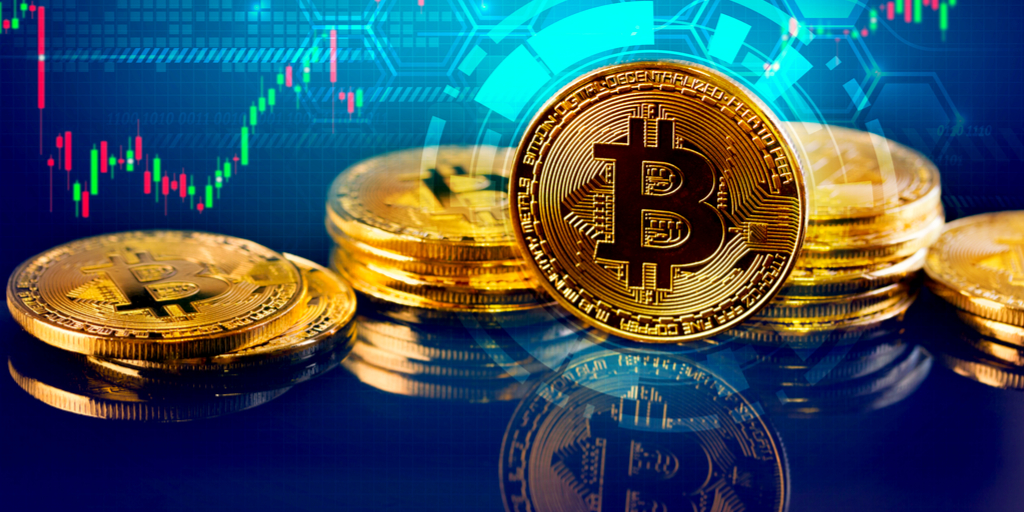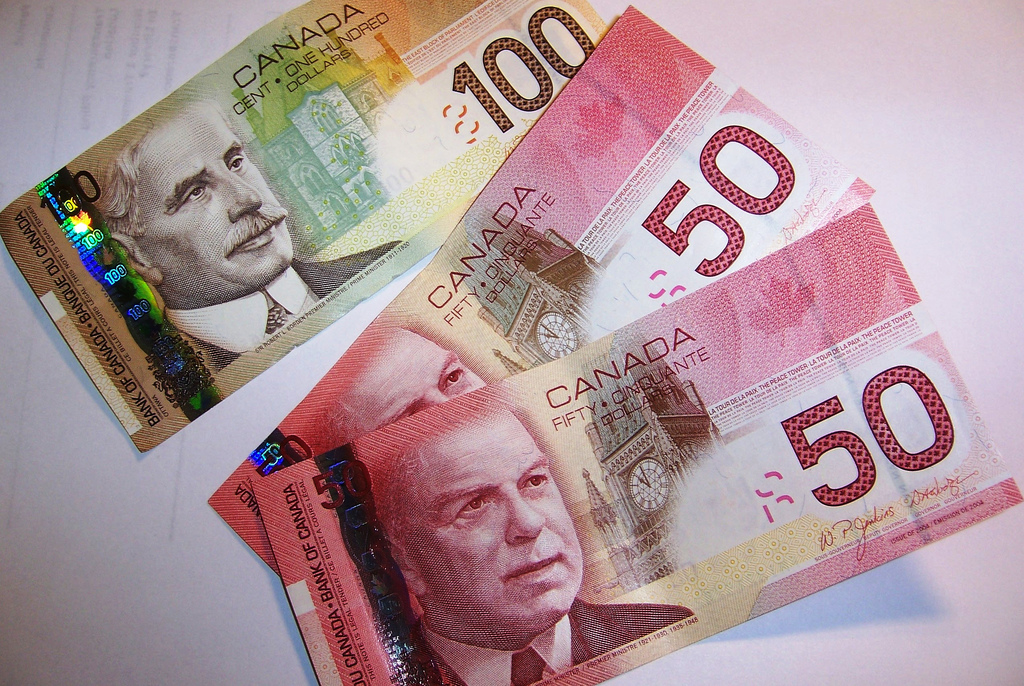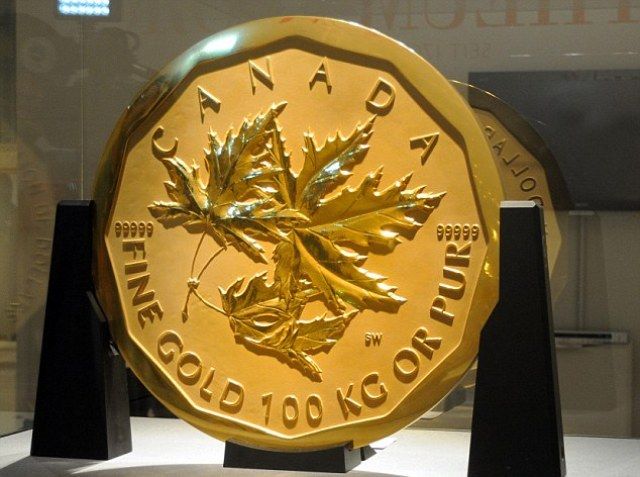Comments Off on China & Russia Buying Gold by the Ton, Canada Has Just Ounces
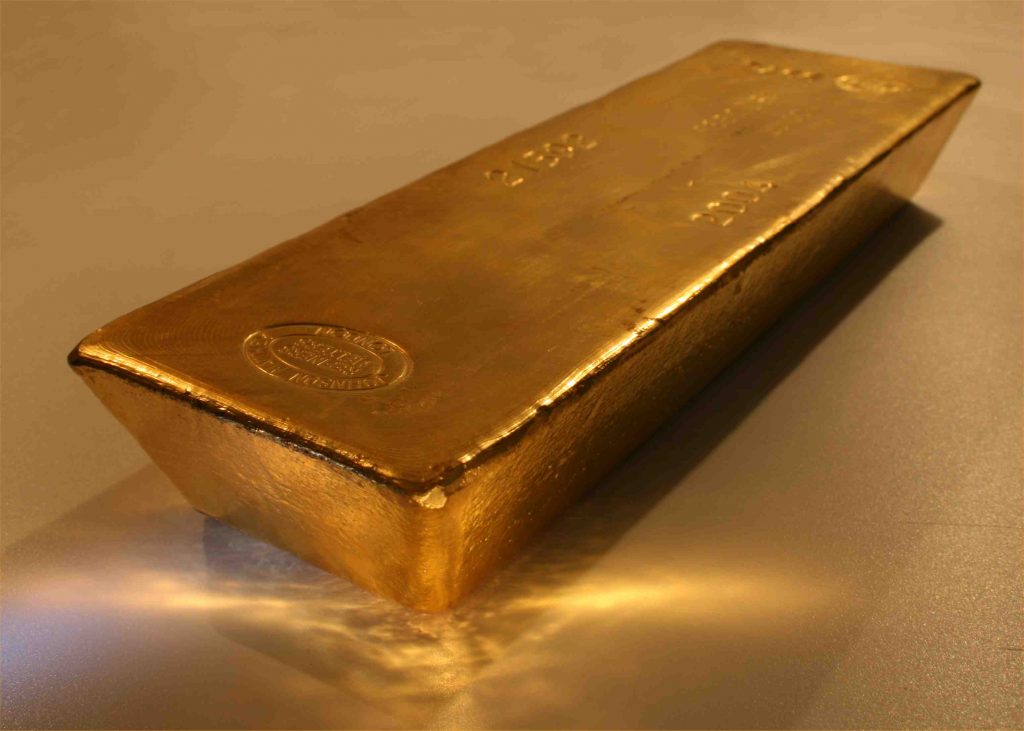
China & Russia Buying Gold by the Ton, Canada Has Just Ounces
Up until just a few years ago, gold was considered a good investment to make, as the market crash of 2008 was not yet forgotten. This is because gold is regarded as a financial safety net. Recently, with the economy shifting and the currency losing power, more and more people are investing in gold like crazy – and this spreads all the way to entire countries.
The attractiveness of gold shows no abating signs – and many central banks are not slow to catch onto the movement. Still, some countries such as Canada have decided to move in a different, nearly gold-free direction – but data shows that the risks involved in accumulating gold are worth taking.
The Chinese and Russian Gold Rush
Global superpowers such as Russia and China have begun buying gold by the ton, as the bullion reserves of both countries have increased substantially. In 2018, the central bank of Russia bought 276 tons of gold bullion – a quantity that was worth more than 11 billion dollars.
As a result, the rush to gold only kept growing. In February 2019, the Russian gold reserve went up by 1Moz – resulting in the country now accounting for about 40% of gold buying. Around 6% of the global gold demand also belongs to Russia. The purpose is to reduce their reliance on the American dollar and increase the economic growth of the country.
China also makes its attraction for gold known. According to the stats from the People’s Bank of China, the country also managed to boost its gold reserves, reaching a total of 60.62 million ounces in March. This is a very impressive number, considering that in February, it stood at 60.26 million ounces.
March marks the fourth month in a row when China increased its gold purchase. During this time frame, this Asian power managed to add 42 tons of gold to its national reserve. To strengthen this move, gold companies from China have also invested about 4 billion dollars since 2011, boosting the reserves of the country by 800 tons.
China is now loading up on its gold reserve at a rate that is relatively steady. This was revealed in 2015 as gold bullion increased almost every month for a longer time frame. Now, China and Russia are turning this into a competition, moving almost head to head in their gold-purchasing spree. With these continuous purchases, they’re hoping that the reserves will grow enough to lessen their reliance on the U.S. dollar.
A Sharp Contrast with Canada
As we can see, China and Russia are not joking when it comes to gold investments. The power of the US dollar seems to be weakening, and the fact that these two powers have stocked up on gold might prove to be both an investment, as well as a separation from the global superpower called the United States.
In sharp contrast to the tons of gold purchased by Russia and China, we have Canada, which only has 77 ounces at this point. This is quite insignificant compared to the amounts held by the other two countries.
Canada began to sell many of its remaining gold reserves, giving it to the general public. By selling the gold coins this way, they reaped better prices than if they dumped a 400-ounce bar to a banker.
In 2015, the gold reserves of Canada were fairly rich, valued at around 100 million dollars. According to the Bank of Canada, around 21,000 coins (21,929 ounces) were sold in February, causing the gold quantities to go down. Before that, they sold around 38,860 ounces in January, and 41,106 in December 2018. After so much gold was sold, Canada was left with the 77 ounces that they had in March – with the numbers dangerously low.
Canada’s official statement was that their decision to sell had nothing to do with a specific gold price. Sales had been going on for quite some time at a steady pace –according to them.
The government has issued a long-standing policy in which they attempt to diversify the portfolio by selling gold and other physical commodities. Instead of gold, they opt to invest in financial assets that could be easily traded and have a great market of both buyers and sellers.
A Potential Shift towards Gold
We see that Canada has not gotten caught up in the gold rush as China and Russia seem to be. However, behind the scenes, the government does realize that they would eventually have to shift from a cash-based society and go for a cashless one. This will allow them to retain economic power.
Still, in order to do that, they will have to separate themselves from the power of the U.S. Still, this fuels the debate that is occurring behind closed doors on how the monetary system should be approached. There is the question of whether the use of this “barbaric relic” is actually needed or not. Is it actually a good idea to invest in Canadian gold coins in this day and age?
Considering the rate at which gold is soaring (and the American dollar dropping), China and Russia seem to have a good idea. Given the economic turmoil through which many countries are going, it is expected that the currency will once again drop – and that the invested gold will start bringing profits. Looking at the stats now, China and Russia would become rich – while Canada will fairly much remain in the same place.
Final Thoughts
Going the socialist route, Canada may have created a dent in their finances. At this point, with their 77 ounces of gold, they’ll never catch up to Russia or China – who already have tons of this precious metal. They know that gold will go up at some point – and in an attempt to shift away from the U.S. dollar, they are giving it their all.
However, by shifting their attention towards mining Canadian gold, Canada might be actually able to reap part of the benefits that China and Russia have. It might take years until Canada also manages to shift away from the dollar – but with careful investment, it can be done.
—
Photo: Bullion Vault
Comments Off on Bitcoin Vs. Gold: Which Is the Better Long-term Investment?
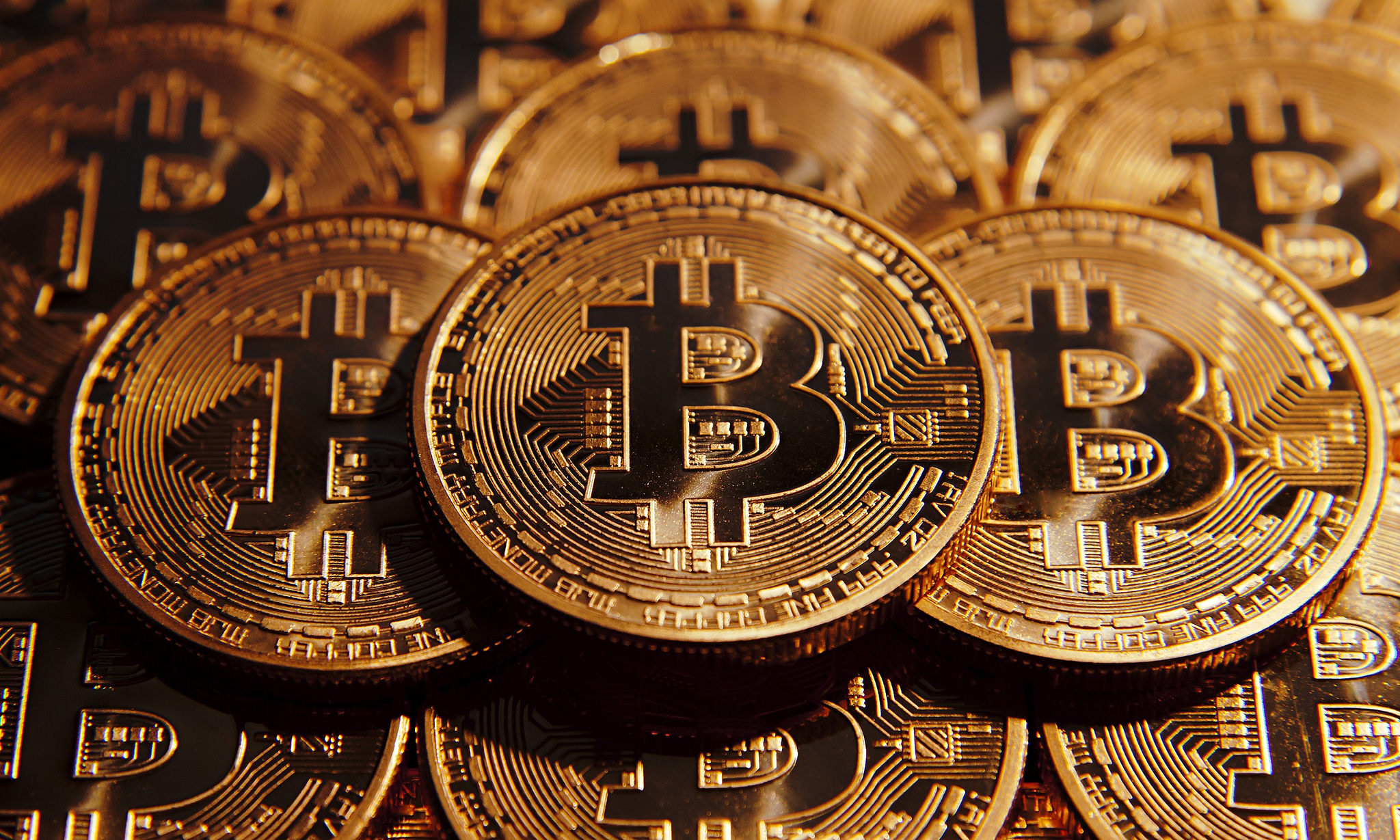
Bitcoin Vs. Gold: Which Is the Better Long-term Investment?
Sure, the bulk of your net worth should typically be parked in real estate, index funds, stocks and bonds. However, Bitcoin and gold are great investment options too.
Since both assets have a limited supply, neither slowly lose value over time due to inflation like the dollar. So, this makes them ideal for use as a store of value.
Bitcoin is the new kid in town, whereas gold has been trusted as a store of value for thousands of years. While Bitcoin has recently gained popularity due to its exponential rise in price, gold has been the go-to option for saving your money over the long term for centuries.
Looking beyond current values of Bitcoin and gold, let us compare these two assets with respect to long-term investment (or as Bitcoin aficionados call it: HODLing).
Perks of Holding Bitcoin Over Gold:
Bitcoin is a cryptocurrency that has become widely popular due to its good usability and exponential increase in value. The rise in value can be attributed to the limited supply and ever-increasing demand which drives the price of each Bitcoin higher. Let’s look at how Bitcoin trumps gold as a long-term investment.
1- Its exponential rise in value: Any investor seeking long-term investments wants assets that have a high rate of return over time. Other than using it just to preserve wealth, you also need growth potential to counteract inflation and to make it worth the risk. While both gold and Bitcoin have seen a tremendous rise in value over the years, no other asset has been as rewarding as Bitcoin so far.
From being available at just 30 cents in 2010 to reaching an all-time high of nearly $20,000 in 2017, Bitcoin has successfully awarded millions to its believers. Additionally, this digital asset took under a decade to experience such success.
Gold is the traditional long-term investment option amongst all of us as it is a precious metal with high liquidity and is limited in supply. This means that the value of gold is going to increase every time its demand outperforms the supply. It took gold several centuries to reach the value it currently sits at. However, this was easily defeated by Bitcoin in under a year. Thus, all these factors have made Bitcoin an attractive choice in recent times.
2- Widespread usage: Both Bitcoin and gold are great stores of value. This is because each has a limited supply and ever-increasing demand increases their value. While gold has high-liquidity (easy to buy and sell), it is not convenient to use it as a replacement for money. Gold coins were historically a common method of payment. But today it is impractical to buy an inexpensive item like a cup of coffee in exchange for gold. On the other hand, Bitcoin is highly divisible.
You can pay with even a fraction of a dollar by using Bitcoin. Due to such high divisibility, the usage of Bitcoin around the world has increased. More and more companies such as Starbucks and Microsoft accept Bitcoin as a payment mechanism. With this growing adoption coupled with increasing demand, the price of Bitcoin has skyrocketed.
Perks of Investing in Gold Over Bitcoin:
Now that we have seen the advantages Bitcoin has over gold, let us take a look at the strengths of gold. Though people started using gold as a store of value centuries ago, saving it is one of the few practices that hasn’t changed.
1- Volatility: This is one of the factors that scares people away from Bitcoin. So far, the value of Bitcoin has increased exponentially over time. However, Bitcoin has also experienced crashes of over 80 percent along the way. It’s always recovered but not everyone can stomach the price action.
As Bitcoin is young and not regulated by any central government, the price swings are dramatic. Widespread investor speculation adds immensely to its volatility. Any news on Bitcoin can result in a huge price shift very quickly.
This is not the case with gold, because it is a regulated asset. This means that there is much less volatility, which will definitely increase the confidence of prudent investors. Due to this factor, the odds of a dramatic decrease in the value of gold is much lower. Additionally, because to its low supply and high demand, its value keeps on increasing. Thus, making it a good investment option for your retirement portfolio.
2- Trust: Gold is an asset that people often fall back on whenever they want to plan for their financial future. Even though this asset is fairly stable, it still provides its users with ample room for growth.
When investing a lot of money, it is very risky to invest in a newer asset like Bitcoin. More often than not, people like to stick to proven methods that have been used for centuries. Because gold is one such investment option, it holds the trust of the people.
As mentioned previously, the value of Bitcoin is largely based on speculation. Since its value is not backed by any physical asset, it has the potential to eventually drop to zero. Additionally, there is not much historical evidence that Bitcoin is safe to hold for a very long time.
3- Easy to use: Using cryptocurrencies such as Bitcoin can be complicated. If you make even one mistake while sending or providing your public address for receiving funds, you will end up losing it all. This is another factor that keeps people from adopting this technology.
Gold, on the other hand, is extremely user-friendly. It is as simple as buying and selling any other item that you want. Also, although carrying gold with you and trading it for goods is impractical, safely storing it to preserve your wealth is very practical. Keeping gold tucked away is a strategy used by governments and millions of people around the world.
Bottom Line:
Bitcoin and gold offer great investment opportunities. While Bitcoin is fairly new, gold has been used for this purpose for centuries. It offers more a stable place for your funds while plenty of room for growth.
Many Bitcoin enthusiasts say that the value of gold will come down once mining gold found in meteors becomes a reality. However, this milestone will take several decades to be accomplished, whereas quantum computers that pose a threat to blockchain security is right around the corner. This makes gold the best long-term investment option right now.
Comments Off on Is Bitcoin Really “the New Gold”?
Is Bitcoin Really “the New Gold”?
The Bitcoin is Gold Crew
Blockchain influencers, the media, and crypto enthusiasts love to compare Bitcoin with gold.
Gemini founders the Winklevoss twins in particular make this comparison often. Tyler has described Bitcoin as a better form of gold or “digital gold.”
[…] speaking in NY City on Feb 27, added his back up on the popular claim by many that the leading coin Bitcoin (BTC) is a digital form of gold. Both gold and bitcoin are scarce, he continued, fungible and divisible. But, he believes that bitcoin is better at being gold than gold is, since you can hold it in a single string of numbers making it much more portable.
Litecoin founder Charlie Lee is also known for drawing comparisons between gold and Bitcoin. He has also called his own cryptocurrency LTC “silver” and went so far to call XRP “diamonds.”
The famous developer commented that if he had to compare Bitcoin (BTC) with some commodity, in his opinion Bitcoin (BTC) is the closest thing to gold that exists in the crypto sphere.
Its massive adoption and the considerable increase in prices make it valuable digital storage for many people. This quality makes it perfect for accurate comparison with gold, being Bitcoin its digital equivalent:
“Bitcoin doesn’t need to face storage problems; it’s also very convenient to transfer. For me, he is better than gold in many places. If you are more optimistic, the market value of Bitcoin may be more than the 10 trillion market value of gold. More than 100 times the upside.” — Charlie Lee
Brave New Digital World
It’s true that we’ve entered an era in which cutting down on physical attachments in favor of the digital equivalent is seen as “better.”
Everyone’s music collection was once on vinyl records, tapes or CDs. Movies were on VHS, DVD, then Blu-ray before moving to pure digital form as well. And while some of us still prefer physical books, affordable tablets and the Kindle have ushered in the digital era for our reading material.
Our banks balances have long been displayed on computer monitors. So, the desire to digitize our holdings in precious metals seems like the next logical step.
A New Asset Class
Let’s get back to the big question. Is it fair to compare Bitcoin to gold?
Many of these comparisons are attempts by Bitcoin boosters to describe a totally new asset class in terms they feel the public can understand.
Bitcoin really could be compared with any commodity. They choose gold because it has historically commanded a high price and it is ingrained in the public consciousness as a symbol of wealth.
The truth is more complex.
Bitcoin creator Satoshi Nakamoto intended it to be a currency. It behaves like a (volatile) commodity or investment, and is bought, sold and held on to like a stock.
Bitcoin and cryptocurrency is a new asset class that has nothing to do with gold. And since gold has held its value relative to the currency since of dawn of civilization, Bitcoin will not replace gold either.
The Bitcoin is NOT Gold Crew
Sean Williams at The Motley Fool slammed the comparison in his article titled ‘For the Last Time, Bitcoin Isn’t the New Gold.’
The world’s largest cryptocurrency by market cap has also drawn regular comparisons to gold, which is viewed as the go-to investment anytime fear, volatility, and/or inflation rear their heads. This comparison takes shape given the relative scarcity of each asset. In other words, there’s a 21-million-coin limit on the number of bitcoin that can be mined, just as there’s a limit on the amount of gold that can be mined from our planet. Therefore, the assumption has been made that bitcoin can act as a store of value much in the same way gold has for investors.
However, I’m here to tell you, again, and for the last time, that you shouldn’t believe everything you hear about bitcoin. It isn’t, and will never be, the “new gold.”
Thijs Maas at Hacker Noon thoughtfully addressed the concept of Bitcoin as the new gold as well.
A lot of people believe that Bitcoin will serve as an effective hedge for economic uncertainty. Assertions like “Bitcoin is the new gold” have at some point appeared on the front-page of pretty much every financial outlet. And there is some truth in this statement. Bitcoin is definitely a great way to escape hyperinflation. It is also true that there is a relatively small correlation between Bitcoin’s price and the prices of mainstream asset categories. However, there is an important difference between gold and Bitcoin: Gold has intrinsic value. Bitcoin does not. A bitcoin costs around 4000 dollar now because we believe it costs 4000 dollars. If one day everybody decides that Bitcoin is worthless, it would be.
The Verdict
While it makes sense to compare Bitcoin with gold to market it, and provide clickbait to the pad the pockets of media outlets, we don’t need to choose one and throw out the other.
Bitcoin and gold are both investments worth considering. Bitcoin is convenient, fairly new and technologically exciting. Gold is still extremely small and lightweight in comparison to its value, and historically it’s the safer bet.
One Bitcoin could someday reach a value of $1 million as predicted by John McAfee, or it could fail and drop to zero. It’s highly risky, but the potential rewards are great.
Gold is just the opposite. It’s a safety net. Even if the entire financial system collapses gold will have value.
—
Photo: Steven Millstein
Comments Off on Half of Canadians $200 Away from Broke, 31% Drowning in Debt
Half of Canadians $200 Away from Broke, 31% Drowning in Debt
If you’re a Canadian with an interest in precious metals investing, consider yourself lucky to be part of an increasingly small club.
It turns out those neighbors that seem to have it all can barely keep up with monthly bills:
More than half of Canadians are living within $200 per month of not being able to pay all their bills or meet their debt obligations, according to a recent Ipsos survey conducted on behalf of accounting firm MNP.
31 percent are sinking in debt a little more every month. 10 percent have just $100 in wiggle room.
House prices are surging, electricity and cellphone bills rank among the worlds highest; it seems Canadians pay more for everything. It’s little wonder how it’s gotten this bad.
However, it’s a weak position to only attribute factors out of ones control. Refusal to adopt lean spending habits and questionable financial literacy are also to blame. The survey also found that “60 per cent said they don’t have a firm grasp of how interest rates affect debt repayments.” Not shocking in the least as you’d have to not understand compound interest to agree to it, or be very desperate.
With an uncanny ability to ignore financial red flags one wonders if even Billionaire investor Warren Buffet in the flesh could straighten them out. He’s often advised:
“The most important thing to do if you find yourself in a hole is to stop digging.”
When CNBC asked him what was the one thing he believed young people should be doing about money, his primary advice was to “stay away from credit cards.” Paying interest on credit cards not only suggests that you are living beyond your means, but it also means that you are losing money. Both courses of action run contrary to Buffett’s philosophy.
Another danger is emerging, and naturally that same uninformed 60 percent won’t see it coming, though they’ll feel it. Variable mortgages are about to skyrocket due to the Bank of Canada’s interest rate hike.
A decision by the BoC to start lifting its key policy rate from historic lows would raise the cost of carrying debt across the country. The Bank uses interest rates, among other tools, to influence inflation and economic activity. Many economists believe it could start to raise rates in the first half of 2018, as economic growth picks up pace.
Isn’t this a cruel trick? Once creditors had the people hooked on cheap credit, they found a way to switch the rules with help from their pals at BoC.
James Laird, president of brokerage firm CanWise Financial has predicted fixed rate mortgages will raise “0.20 to 0.25 of a percentage point.”
This could push the spread between 5-year fixed-rate mortgages and 5-years variable-rate mortgages beyond 1 percentage point, said Laird, a threshold beyond which there is generally a sizable increase in the number of Canadians who will opt for variable rates.
Americans are a little better off, but not by much. CEO of cell phone insurer Assurant noted this on Bloomberg TV:
“The reality is, half of Americans can’t afford to write a $500 check,” Colberg said. We decided to look into the CEO’s claim about the woeful state of US finances. What we found is that according to a recent Bankrate survey of 1,000 adults, 57% of Americans don’t have enough cash to cover a mere $500 unexpected expense.
[Infowars]
Money is working against the average North American, not for them. It’s a difficult cycle to stop, because it’s rooted in a faulty mindset. Frugality, saving and investing isn’t sexy. Photos of expensive vacations get us more likes on social media, and displays of lavish spending give us a quick fix of positive reinforcement in our image-orientated culture. Living for the now is important, but some sacrifice is required for a better future.
Warren Buffett decorated his office with Depression-era photos to remind him that even in times in prosperity you need to prepare for the worst.
Wake up Canada! If a small repair to your aging Hyundai sends your personal balance sheet into the red, it’s time to break free from the herd. Stop borrowing and start investing.
—
Photo: Eric L
Comments Off on Top 6 Significant and Rare Canadian Gold Coins
Top 6 Significant and Rare Canadian Gold Coins
Canada has a colourful heritage in its gold coinage. On one hand the Royal Canadian Mint makes one of the most coveted gold bullion coins in modern times, and on the other Canada has a track record of circulating gold coins for very brief periods before times of radical change such as the start of WWI or the end of the gold standard.
Originally this was intended to be a top 10 list. However, the Royal Canadian Mint has consistently been issuing collectable gold coins with low mintages and hefty price tags, and only time will tell which of these more recent designs will earn a place in history. Gold coins with the potential for future greatness are listed at the very bottom under honorable mentions.
6. Canadian Gold Maple Leaf (1979-present)
 These may not be rare like many of the other coins on this list, but the Canadian Gold Maple Leaf earns its place here for exactly that reason: it’s popularity and importance in the international gold bullion market. According to the ‘AMPEX Top 40’ products, only the Gold American Eagle and Gold Buffalo sold better, shooting ahead of even the staple South African Krugerrand.
These may not be rare like many of the other coins on this list, but the Canadian Gold Maple Leaf earns its place here for exactly that reason: it’s popularity and importance in the international gold bullion market. According to the ‘AMPEX Top 40’ products, only the Gold American Eagle and Gold Buffalo sold better, shooting ahead of even the staple South African Krugerrand.
The other claim to fame is these are the purest mainstream gold bullion coins available with a purity of .9999 since the revision in 1982.
5. The Spirit of Haida Gwaii (2007) – 10 Kg Gold Coin
 An important landmark for the Royal Canadian Mint, this was the world’s first 99.999% 10-kg pure gold coin. Unlike the million dollar coin made in the same year, it was intended for public release. No more than 15 were produced.
An important landmark for the Royal Canadian Mint, this was the world’s first 99.999% 10-kg pure gold coin. Unlike the million dollar coin made in the same year, it was intended for public release. No more than 15 were produced.
The coin was given the second highest denomination ever by the mint at $100,000. Considering the value of the gold alone it’s currently worth almost $550k CAD!
4. Canadian Gold Sovereigns (1908-1919)
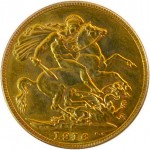 Gold sovereigns have a long history in the UK; the first were minted in 1489 during the reign of Henry VII. Over 400 years later, Canada was the first country outside Britain to issue gold sovereigns starting in 1908.
Gold sovereigns have a long history in the UK; the first were minted in 1489 during the reign of Henry VII. Over 400 years later, Canada was the first country outside Britain to issue gold sovereigns starting in 1908.
The period of minting during the rule of George V, only produced 628,152 Canadian gold sovereigns in total, making all dates rare and in some cases exceptionally scarce. There are fewer than 50 1916 C gold sovereigns still in existence, which makes it one of the rarest and thus valuable Canadian coins.
3. $5 and $10 Bank of Canada Gold Coin (1912-1914)
Historians have noted these briefly minted $5 and $10 gold coins were discontinued and yanked from circulation to stop gold from leaving Canada during World War I. Additionally this is the time Ottawa suspended the gold standard.
In 2013, The Globe and Mail reported that the conservatives had plans to melt down more than over 200,000 coins still owned by the government, and 30,000 would be sold to collectors.
2. $2 Newfoundland Gold Coin (1865-1888)
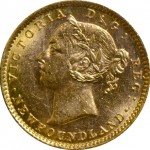 Minted intermittently during the reign of Queen Victoria, it was the only gold coin in circulation issued by a British colony. Newfoundland was self-governed so the choice to issue the coinage of their choice was done independent of the influence of the UK.
Minted intermittently during the reign of Queen Victoria, it was the only gold coin in circulation issued by a British colony. Newfoundland was self-governed so the choice to issue the coinage of their choice was done independent of the influence of the UK.
In April 2014 a Newfoundland gold coin was sold for a record high of $102,812.50 USD at a major auction in Chicago. It was a one-of-a-kind test design for the $2 Newfoundland gold coin which wasn’t chosen.
1. Million Dollar Coin (2007)
With a face value of $1-million and a true market value of at least $5-million according to current gold prices, this giant coin is the king of Canadian gold coinage.
Originally the Royal Canadian Mint made just one to promote its new line of .99999 pure Maple Leaf bullion coins. When buyers with exceptionally deep pockets showed a great interest in getting one, more were minted. Today a total of five are scattered around the world, and one is in a vault in Ottawa.
A million-dollar coin was stolen from a German museum in 2017. Thieves used a three-meter-long ladder to enter the back of the Bode, then carted it away in a wheelbarrow!
Honorable Mentions
In the Eyes of the Timber Wolf – Fourth in the series of wildlife coins with a selective enamel, it weighs in at one-kilogram and is 99.99% pure gold. Only 10 minted in 2017 with a price of $69,000.00!
A Celebration of Her Majesty’s 90th Birthday – The first gold coin to feature 29 Canadian diamonds and a large AAA cabochon emerald at its center. Only 125 minted in 2016 with a price tag of $6,999.95.
90th Anniversary of the Royal Canadian Mint – Just 1,999 minted and originally sold for $999.99 in 1998.
The Golden Slipper (Flower of Prince Edward Island) – .99999 fine, only 1,990 minted and originally sold for $999.99 in 1999. Housed in a fancy gold box; no, not the real kind.
1976 22kt $100 Olympic Commemorative Gold Coin – Two versions were released, one 14kt and the other 22kt. Naturally the 22kt version is worth significantly more.
